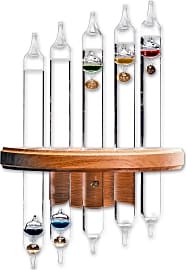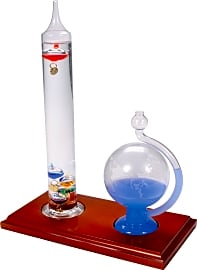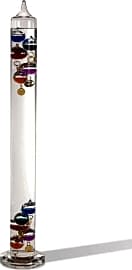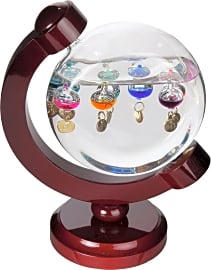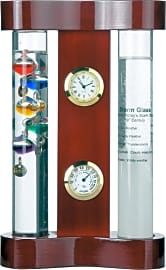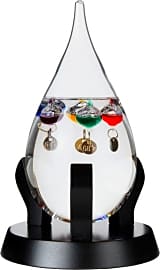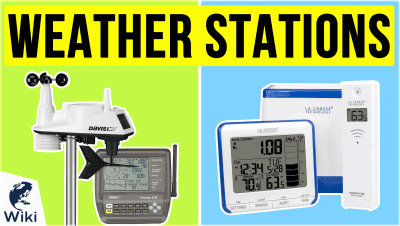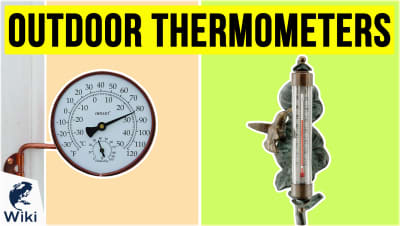The 9 Best Galileo Thermometers

This wiki has been updated 39 times since it was first published in May of 2016. When decorating rooms in your home or office, don't just take the easy option of displaying the same old prints and tchotchkes. Instead, add a little originality and ingenuity with one of these Galileo thermometers. Made using glass, liquid, and colored, weighted floats, they're both elegant as well as relatively functional, as they are able to display the temperature with moderate accuracy. When users buy our independently chosen editorial choices, we may earn commissions to help fund the Wiki.
Editor's Notes
April 14, 2020:
Galileo thermometers are a more elegant solution to determining the temperature than using a digital or traditional one in your home. While they may not be as accurate down to such a small increment, they, without a doubt, have a much more attractive aesthetic. Rather than simply put together a list of boring, single-cylinder options, we thought our readers would appreciate a more interesting selection of designs to choose from.
If you are looking for something to completely take the place of your indoor weather station, the Ambient Weather WS-YG501, Lily Home Analog Weather Station GL08, and Lily's Home SW238A are worthy options. The first two feature a hygrometer and barometer in addition to the thermometer, while the last foregoes the barometer in favor of a storm glass to help you predict the chance of rain a couple days out. The Lily's Home SW238A also adds a clock into the mix. If you don't care that much about the current relative humidity in the air, you can opt for the AcuRite Barometer Set 00795A2, which is almost identical to the Ambient Weather WS-YG501, just minus the hygrometer and with a wooden stand that has a slightly more pronounced grain structure.
If you want to really make a statement in your home, you should look to one of the larger options on our list, such as the Wind & Weather IN6808, which stands at 18 inches tall and has an attractive cherry-finished wood frame; the wall-mountable Hokco Wall Mount, which has individual tubes for each of its colored spheres; or the Wind & Weather IN6807, which though having a basic, frameless design, stands at an eye-catching 20 inches tall.
The Lily's Home Round SW237 and Lily's Home Teardrop SW484 come in shapes not often found in Galileo thermometers, which can make them an appealing choice for people who pride themselves on having decor that eschews traditional norms.
Special Honors
Hanging Galileo Thermometer 46494 Suitable for outdoor use, the Hanging Galileo Thermometer 46494 is a great way to add a little extra charm to a garden or porch. It glass cylinder sits within a metal frame that has a decorative finial at the bottom and a large hook at the top. The entire unit measures 18 inches tall. bitsandpieces.com
What On Earth?
Suspended in the tube are a handful of small glass spheres, also known as divers, which contain different amounts of colored solution.
Despite being named after the celebrated 16th-century physicist Galileo Galilei, the Galileo thermometer was actually invented by a group of science enthusiasts and academics that belonged to a society known as the Accademia del Cimento, which included a few of his students. Because it's based on Galileo’s theory of buoyancy, it was named in his honor. It’s generally thought that Galileo invented a similar type of temperature-sensing device known as a thermoscope. This tube-shaped apparatus was made of glass and contained liquid that would rise and fall to signify a change in the surrounding air. This innovation served as the inspiration for his namesake thermometer.
Although there are now more precise ways of gauging the temperature, the Galileo thermometer endures as a decorative contraption that nonetheless is still fairly accurate, with a slight margin of error of plus or minus a few degrees. The way it works is actually pretty ingenious — it’s based on the simple idea that a liquid’s density changes along with the temperature. If the air around it is warm, water will expand and subsequently decrease in density. The opposite occurs if it happens to be cold outside.
A typical Galilean thermometer consists of a vertical glass cylinder filled with liquid, which can be anything from distilled water or alcohol to mineral spirits. Suspended in the tube are a handful of small glass spheres, also known as divers, which contain different amounts of colored solution. If you look closely, you'll notice that these floating balls have a small attached tag labeled with a number that denotes a measurement in Fahrenheit or Celsius. More than just a pretty ornament, these tags have a specific mass that has been carefully calibrated to correspond with the sphere and the fluid inside it, in order to match the temperature that it’s correlated with. So, if the air in the room heats up to, say, 78 degrees, then the solution in the glass tube will react by expanding, its density decreasing in the process. Because it has been carefully weighted to respond to that specific temperature, that 78-degree ball will float to the proper height while the others rise and sink accordingly.
Reading a Galilean thermometer is relatively straightforward. You can determine the correct temperature by looking at the lowest floating bulb. If there’s a wide gap between two suspended spheres, the temperature is somewhere in between them. If all the divers rest together at the bottom, then look to the highest one for an accurate reading. It’s not the most foolproof method out there, but watching these radiant spheres gracefully drift to and fro makes for aesthetically pleasing entertainment. It’s quite easy to appreciate the beauty of such an instrument.
It’s All Relative
Choosing the right Galileo thermometer for your home or office depends entirely on your personal preferences. If you're simply looking for a conversation starter, a classic freestanding cylinder-style model will most likely suffice. However, if you're seeking to up the wow factor, opt for a larger, teardrop-shaped piece with a wooden base or frame. Dark cherry finishes tend to pair particularly well with jewel tone liquids and gold or brass tags. Look for options that are artisan-made with hand blown glass, this way you know you'll be receiving a unique, high-quality item that will look perfect in a study, kitchen, or protected outdoor area.
This way, if it happens to tip over in your absence, it will most likely survive the fall.
If you have kids or pets hanging around, you may want to invest in a device that’s resistant to breaking. This can be easily achieved by nabbing a thermometer that’s housed in sturdy casing, be it wood or metal. This way, if it happens to tip over in your absence, it will most likely survive the fall. Another way to safeguard your little ones is to choose one that is filled with non-toxic liquids in the unfortunate event that it does break when you’re not around. You can also reduce the possibility of a mishap by selecting a style that mounts to the wall. There are plenty of attractive options available, from vintage-styled decorative brackets that resemble elegant sconces to multi-tube kits that rest in durable, yet stylish, frames. Just be sure to secure them well out of the reach of curious children.
Are you looking for a full-blown weather station? Plenty of sets come with built-in barometers and hygrometers that monitor the surrounding air pressure and humidity levels. Some boast clocks and storm glass, which are antique-looking devices that help predict the weather, for example whether it will rain or not. A thermometer complemented with accurate tools will have you well-equipped to manage your day accordingly and plan ahead for inclement conditions.
A Brief History Of The Thermometer
People have been attempting to measure temperature since antiquity. The thermometer as we know it today went through an evolution of ideas. Hero of Alexandria had one of the earliest notions of such an instrument. He described an experiment in which a closed tube filled with air was left with one end immersed in water. As the temperature would fluctuate, the air within the cylinder might expand or contract, moving the tube. This idea expanded over the centuries and was especially refined in Europe from the 1500s onward, with scores of brilliant minds making contributions along the way, most notably Galileo for his thermoscope and Robert Fludd, who was the first to use a scale of measurement.
It wasn't until 1714 that the thermometer came close to resembling the instrument we're familiar with. Dutch scientist Daniel Fahrenheit used mercury instead of water to great effect. He later invented his eponymous temperature scale, which underwent adjustments and is still in use today. A few decades later, Anders Celsius devised his own approach, with zero degrees to denote water's boiling point and 100 as its freezing point. This system, although now reversed, has been adopted by the majority of the modern world. We currently have a litany of thermometer types, including quick and accurate digital options for determining if you have a fever, and infrared types used in the culinary and automotive industries.




